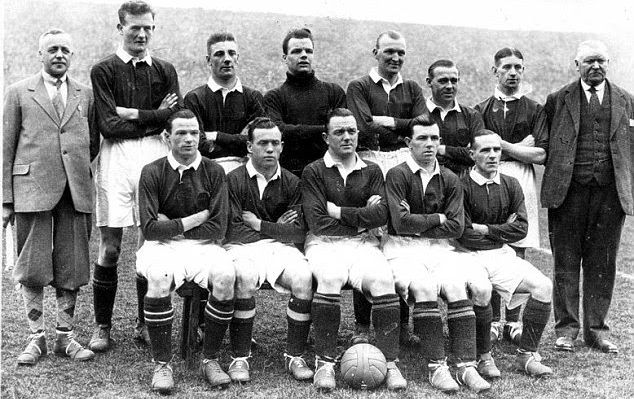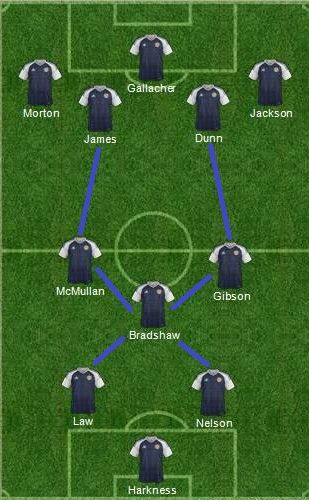The Wembley Wizards

From the resumption of football after The Great War Scotland had done well. The first game back had been a 1:1 away draw to Wales followed by 3:0 home-win against Ireland. And, although the game against England was lost, it was away and Scotland had been two up at half-time only for the English inside-forwards to give the Scots half-backs the run-around in the second. In any case neither Scotland of England took the Home Championship. That went to Wales. But over the next seven years Scotland would take that same championship five times with one shared and in the process not lose to England once.
But there were by the time of the England-Scotland match of 1928, and it was England-Scotland to be played at Wembley, there were two problems and a challenge. The first is that, whilst in 1927 the Home Championship had been shared England, the Scotland-England match, the home Scotland having got one-up then conceding two goals to Dixie Dean, the second two minutes from the end, had been lost. The challenge was for the new President of the Scottish Football Association (SFA), Robert Campbell. And the second problem was that so far in 1927-28 having only drawn with Wales, albeit away, it had just lost to Ireland, effectively Northern Ireland, and at home. A loss against England would leave Scotland on just a single point and in last place, something that had never happened before.
The Scotland team was chosen then by the selection committee and mysteriously. Campbell changed that. First of all he properly chaired the process and secondly applied a rigour not obviously seen before. Scotland could draw on good players. In a sense too many, including one of the World's best at the time, Alex Jackson. The expected conditions were assessed. Heavy rain was forecast and, indeed, it came. Specific threats were identified, notably the prolific Dean, with attention rather than hope applied to nullification. And a little, gentle psychology was employed. The team, which had travelled down the day before the match, was allowed the evening before, albeit with a ten o'clock curfew.

On the day the forward line selected was small but robust. A chance was taken on Hughie Gallacher, who was on his way back from injury and a formation was chosen that today would generate a glance but was then innovative, certainly internationally and more than certainly for a Scottish eleven.
Nor was Gallacher the only punt on personnel. John Harness in goal was still an amateur, Tommy Law at left-back was winning his first cap and Jimmy Nelson on the right only his third. The trio had seven appearances between them. England's three had more twice the number. However, in the half-backs it was the reverse. Whilst in terms of age and therefore legs the outside-halves were equivalents, the two Scots had twice the experience and England's Headless was out of position. At the last minutes he had had to replace Syd Bishop, whose mother was Scots. Perhaps she had had a word. Moreover, as the Scots captain on the day, Jimmy McMullen, playing in England, would after the game observe, those English half-backs made the mistake of marking their opposite wingers and not the inside-forwards.
Summing up a fundamental difference between the Scottish and now modern global games and the then English one, he would say,
"I want to emphasise that all our forwards are inherently clever. ... But I wish to say that the English tactics were wrong. The Saxon wing-halves paid more attention to the wingers than the inside forwards – therefore the latter were given a lot of space. It is a common thing in England to let wing halves, and not fullbacks, mark the wingers. It doesn’t pay and I don’t know why they pursue it."
And that in terms of difference generally and on the day was not all. Both teams played a centre-half, both winning their first caps. Tommy Wilson in white did it English conventional, i.e. between his outer halves. Tom Bradshaw in blue would one-off reverse the Scottish norm. Since 1888 the Scots national team had understandably employed the the Scottish centre-half, the pivot between attack and defence in front of the half-backs, The Cross, the advanced Cross. On this soggy last day of March Bradshaw did what he did at League level at Bury and a bit more. He took his club position betwixt and then dropped back a bit into a cross still but now a defensive one. It meant that with him there, six feet tall and physically imposing, and the 6ft 2ins Jimmy Gibson at right-half Dean on the ground and in the air had more than a handful to deal with and was snuffed out.
So what happened. England hit the Scots post with the first attack of the game, Harkness beaten, Alex Jackson scored in four, a header from a Morton cross, and then they slugged it out until the 44th minute when James jinked and slipped in the second. Then after the break Morton crossed once more in the 65th again onto Jackson's head, the teams restarted, Scotland regained possession, attacked, shot and a minute later James was on the rebound. And it would be the wingers to complete a hat-trick five minutes from time, this time Morton onto Jackson foot.
England were able to pull one back direct from a free-kick a minute before time but the job was already well and truly done. Scotland were heading for the bath. Alex James after the game simply remarked, "We could have had ten!"